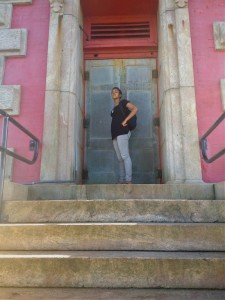By Grace Elkus and Anne Marie Glen, 2013
In the small town of Siler City, North Carolina lies a hidden gem: a bustling and ever-growing community of local artists. Arguably the most intriguing of these artists is a man named Roger Person, owner and artist at the main street studio cleverly named Person to Person Art. Passersby are lured inside by a life size sculpture of a neon-colored cow out front, and once inside, sculptures and paintings of all sizes and mediums surround you. There are canvases hand-stretched into unusual shapes, broken down mannequins that have been reassembled and painted into strange but wonderful sculptures, and, in his second studio across the street, an installation piece entitled “The Debate” made of several papier-mâché characters arranged in a circle.
The artist himself is perhaps the most interesting of all. Originally from San Francisco, Roger Person began his art career twenty years ago after a disabling accident left him in a wheelchair. The inspiration for his unusual and exciting art comes from a lifetime of adventure, which is nothing short of horse racing across the Western United States, racing motorcycles in the desert and downhill alpine skiing.
“I only worked maybe six months a year, and I’d take six months off and go do things,” he said. “I’ve done a lot of different things. I’ve got a lot of memories and experiences to draw from.”
Person’s demeanor is so calm and nonchalant that when he talks, you wonder if he’s joking. But his warm and genuine smile makes you believe his adventurous past, and his larger-than-life artwork is a testament to his exploratory and daring lifestyle. After meeting his wife while living beachside between San Francisco and Santa Barbara, the two moved to Wisconsin and lived on a beautiful piece of wooded, lakeside property. There, he crossed off another item on his bucket list – building a log cabin. After spending twenty years between Wisconsin and Tucson, Arizona, he relocated to Siler City after visiting the area with a friend. Person was drawn to the small town not because of a thriving art community, but rather the lack thereof.
“(My friend) came down to visit his brother, and this little art community was just getting started,” he said. “I could live anywhere I wanted to at the time. But I’d just be another guy. Here, I was the first one to have his own gallery and studio. It was a challenge to try and build an art community from zero. But it’s just another adventure.”
The Siler City artists continue to come up with new and interesting pieces in hopes of drawing visitors and art collectors to Siler City. Creativity is never a challenge for Person, who now has two studio spaces and is always defying the boundaries of what art traditionally is. Person describes his art as “multi-dimensional assemblages,” and it’s easy to see why he needs such a complex phrase when you take a look around the gallery. A small tree erupts from a teal mannequin torso, a chair balances on four mannequin legs and boasts a black giraffe head, and sculptures created from glass, metal, clay, wood, and stone surround the room. Seemingly nothing is off limits- Person showed us more than one piece that incorporated goat skin, which, he explained, gets pliable when wet and shrinks to size as it dries. His workshop behind his studio overflows with mannequin parts, one of his favorite bases for art. He considers himself lucky that he can be so experimental.
“I’ve got an income that sustains me, so I can do all this goofy stuff. If someone likes it, fine, if they don’t, that’s okay too. I’m down here, I’m just playing with ideas and trying to do things.”
Although his art is unique and quite intricate, he produces it at a rate that makes a visitor to the studio want to come back time and time again to see any new additions. Assembling the various pieces comes naturally to Person, who works on his art for three to four hours each day and claims to favor no medium over another.
“What I try to do is use different mediums and combinations,” he said. “I have an engineering and construction background, household manufacturing, so I have a good idea of how things work and go together mechanically.”
Each piece has its own unique and whimsical concept. Person’s sculptures include a playful blue Japanese spirit riding a skateboard in 3D, sitars with the legs of baby dolls, and a mottled blue mannequin lounging vertically, mounted on the studio wall. He has a collection of paintings depicting neon animals in the desert under the night sky. His second studio features a series of cigar boxes filled with baby dolls, clocks, and other paraphernalia. There is not one item the eye can just carelessly pass over, and every piece is subject to change.
“A lot of times, I’ll (start) something, and I don’t quite know how I’m going to do it, and I’ll move onto something else, and I’ll get an idea,” he said. “Then I’ll come back to things that I’ve finished that have been sitting around for a long time and say that wasn’t very good, and I’ll add something else onto it.”
If you are anywhere near Siler City, stopping by Person’s studio is a must. There are too many inspiring pieces to miss, and even if you are not a professed art lover, you will find something in Person’s studio that brings a smile to your face or stays on your mind for the rest of the day. Places like Person to Person art are few and far between, and Person himself is happy to talk to anyone who is interested in his art. To experience him and his artwork is well worth your time.
























